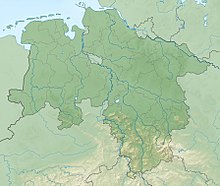Beienroder wood
Coordinates: 52 ° 19 ′ 49 ″ N , 10 ° 42 ′ 59 ″ E
The Beienroder Holz is a deciduous forest area in the municipality ofehre in the Lower Saxony district of Helmstedt .
General
The Beienroder Holz is a closed forest area southwest of Wolfsburg and northeast of Braunschweig . A large part of the Beienroder wood is designated as a nature conservation area of around 696 hectares and an FFH area of almost 547 hectares . The area designated as an FFH area is also part of the EU bird sanctuary “Deciduous forests between Braunschweig and Wolfsburg”. In the north-west, the "Beienroder Holz" nature reserve borders the "Schuntertal" nature reserve. A nearly 170-hectare area in the southwest of the forest area is as DBU - natural heritage area managed. This area is completely outside the landscape protection area. It comprises an area formerly used by the military, on which an army ammunition plant for the Wehrmacht was built from 1934 . The area was used as an ammunition depot after the Second World War . After the Bundeswehr left , it was handed over to the German Federal Environment Foundation in 2014 . The designation of the FFH area and an area adjoining it to the west as a nature reserve is planned. This would extend over approximately 559 hectares.
The forest area is criss-crossed by numerous forest trails . In the east it borders or is crossed by the Autobahn 39 , in the south the Autobahn 2 runs through the foothills of the Beienroder wood. In the north and north-west it borders on Kreisstraße 38, which runs between Lehr and Hattorf , and in the north it borders on Flechtorf . In the south, Kreisstraße 58 crosses the forest area between Lehr and Botenkamp. The area is largely surrounded by agricultural land .
description
The Beienroder wood is characterized by deciduous forests with partly very old trees on historically old forest locations. The forests are partly characterized as moist oak-hornbeam forests , and in small areas also as oak forests on sandy soil, as well as grove or woodruff beech forests . Depending on their characteristics, common oak and hornbeam , common and sessile oak and red beech are the dominant tree species. Depending on the location, there are silver birch and downy birch , rowanberry , aspen , Scots pine , bird cherry and winter linden . The forests have a high proportion of old and dead wood . In the oak forests, layers of bushes and herbs are well developed. Here u. a. Chickweed , wood sorrel , forest honeysuckle , cowslip , flutter grass and blackberry . In addition, well-developed are forest inside edges with herbaceous and shrub rich seams to find. In places, relics of old middle and hat forest management have been preserved.
The forest area is crossed in several places by small, natural streams . There are also various small still waters to be found. In the east is the "New Meadow", an extensively used grassland with grass and shrub vegetation as well as sedge beds and reed beds embedded in the Beienroder wood. The grassland is partially divided by old hedge structures. On a humid to wet site adjacent to the "Neue Wiese", a small area of quarry forest with black alder and ash grows .
The forests are the habitat of species-rich flora and fauna. They offer, among other bird species Black Stork , Crane , Red Kite , Honey Buzzard , Hobby , black , gray and middle spotted woodpecker , wryneck , red-backed shrike , Kingfisher , Nightingale and Oriole and various other songbirds a suitable habitat. In studies on the occurrence of bats 13 species were recorded, including greater mouse-eared , Noctule , water , Pug and Bechstein's bat . The bats benefit from the former bunkers of the ammunition plant as winter quarters. The still waters with their surrounding forest habitats accommodate the crested newt and are the habitat of other amphibian species . The forests are home to numerous species of insects , including various bumblebees , bees and wasps . Even ants are present numerous. Old and dead wood provide a habitat for wood-dwelling beetle species , including the hermit . Almost one hundred species of beetles have been detected in the Beienroder wood, which are at least endangered, sometimes also endangered or threatened with extinction. The area is a potential habitat for wild cats and lynxes .
Web links
Individual evidence
- ↑ Beienroder Holz , profiles of the Natura 2000 areas, Federal Agency for Nature Conservation . Retrieved February 17, 2020.
- ↑ DBU natural heritage site Beienroder Holz , German Federal Environmental Foundation. Retrieved February 17, 2020.
- ^ Environment Foundation takes over the "Beienroder Holz" , Wolfsburger Allgemeine Zeitung / Aller-Zeitung , May 13, 2014. Accessed on February 17, 2020.
- ↑ a b c d Draft of the ordinance on the nature reserve “Beienroder Holz” , Helmstedt district (PDF, 122 kB). Retrieved February 17, 2020.
- ↑ DBU Natural Heritage Beienroder Holz , profile, German Federal Environment Foundation (PDF, 1.3 MB). Retrieved February 17, 2020.
- ↑ Maria Lüer: The forest is still wild here , Neue Braunschweiger , February 28, 2017. Retrieved on February 17, 2020.
- ^ Draft of the justification for the ordinance on the nature reserve “Beienroder Holz” , Helmstedt district (PDF, 510 kB). Retrieved February 17, 2020.



